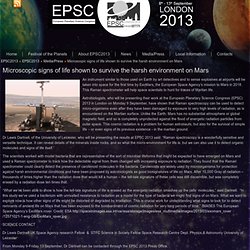

We Finally Know What Happened to Water on Mars. Ancient Mars Was Wetter and Warmer Than We Ever Realized. Liquid Water on Mars. What Kinds of Life Forms Could Actually Live on Mars? Nasa scientists find evidence of flowing water on Mars. Liquid water runs down canyons and crater walls over the summer months on Mars, according to researchers who say the discovery raises the chances of being home to some form of life.

The trickles leave long, dark stains on the Martian terrain that can reach hundreds of metres downhill in the warmer months, before they dry up in the autumn as surface temperatures drop. Images taken from the Mars orbit show cliffs, and the steep walls of valleys and craters, streaked with summertime flows that in the most active spots combine to form intricate fan-like patterns. Scientists are unsure where the water comes from, but it may rise up from underground ice or salty aquifers, or condense out of the thin Martian atmosphere. “There is liquid water today on the surface of Mars,” Michael Meyer, the lead scientist on Nasa’s Mars exploration programme, told the Guardian. “Because of this, we suspect that it is at least possible to have a habitable environment today.”
Ancient Mars May Have Been More Habitable Than We Thought. Kinja is in read-only mode.

We are working to restore service. And unfortunately has no magnetic field. Flagged. Finding Mars' Ancient Ocean. Evidence for indigenous nitrogen in sedimentary and aeolian deposits from the Curiosity rover investigations at Gale crater, Mars. Here's why everybody is freaking out about methane on Mars. Microscopic signs of life shown to survive the harsh environment on Mars. An instrument similar to those used on Earth by art detectives and to sense explosives at airports will be taken into space for the first time by ExoMars, the European Space Agency’s mission to Mars in 2018.

This Raman spectrometer will help space scientists to hunt for traces of Martian life. Astrobiologists, who will be presenting their work at the European Planetary Science Congress (EPSC) 2013 in London on Monday 9 September, have shown that Raman spectroscopy can be used to detect micro-organisms even after they have been damaged by exposure to very high levels of radiation, as is encountered on the Martian surface. Unlike the Earth, Mars has no substantial atmosphere or global magnetic field, and so is completely unprotected against the flood of energetic radiation particles from outer space. This cosmic radiation is a problem for human astronauts, but also for the survival of simple life – or even signs of its previous existence - in the martian ground. www.europlanet-eu.org.
Mars could have developed life more quickly than Earth. Mars is a real (but kind of depressing) reminder that, no matter how many "Earth-like" planets we find, the odds are still astronomical that one can support life and even more so that it actually does end up supporting life.

Out of the 1000 planets we've found so far, none are a better candidate for life than Mars and Mars becomes more and more of a perfect candidate the more we learn about it. It definitely had liquid water. It very probably had basic life at one point. If Mars could get so close but end up so far from where Earth did, what chance do SO SO many other planets we find.
Of course with billions of planets, yes the statistics are in our favor, but still, I find it humbling to remember that Mars, if we discovered it a few lightyears away, would have all the hallmarks of a PERFECT candidate for habitable life... yet here it sits dry and barren. 2014 March 9 - A Hole in Mars. Discover the cosmos!

Each day a different image or photograph of our fascinating universe is featured, along with a brief explanation written by a professional astronomer. 2014 March 9 A Hole in Mars Image Credit: NASA, JPL, U. Arizona Explanation: What created this unusual hole in Mars? Tomorrow's picture: darker matters Authors & editors: Robert Nemiroff (MTU) & Jerry Bonnell (UMCP)NASA Official: Phillip Newman Specific rights apply.NASA Web Privacy Policy and Important NoticesA service of:ASD at NASA / GSFC& Michigan Tech.